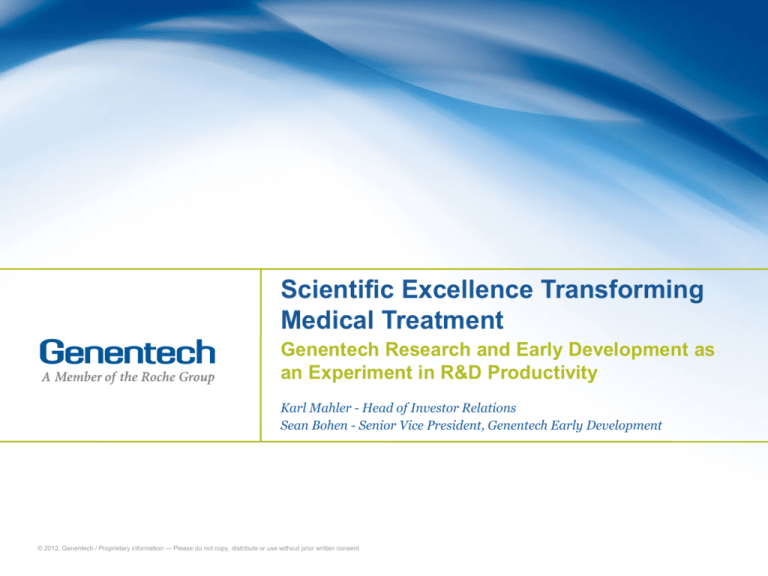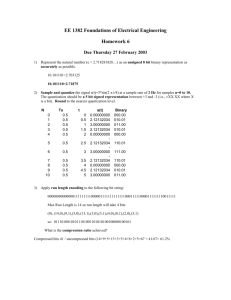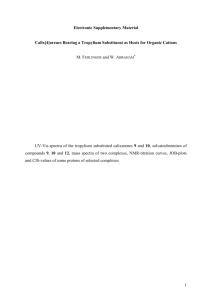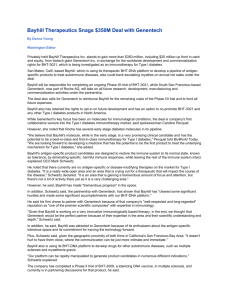Scientific Excellence Transforming Medical Treatment
advertisement

Scientific Excellence Transforming Medical Treatment Genentech Research and Early Development as an Experiment in R&D Productivity Karl Mahler - Head of Investor Relations Sean Bohen - Senior Vice President, Genentech Early Development © 2012, Genentech / Proprietary information — Please do not copy, distribute or use without prior written consent Roche Group 2 An innovation network Academia & industry Independent centers for research and early development Over 150 partners gRED Global Product Development pRED Manufacturing Chugai Roche Diagnostics © 2012, Genentech / Proprietary information — Please do not copy, distribute or use without prior written consent Worldwide execution Commercialisation R&D productivity of Pharma industry 3 Output relatively flat, while R&D costs have increased Industry R&D spend (US$ bn) # NMEs approved 60 55 50 50 45 40 40 35 # New Molecular Entities (NMEs) (lagging 5 year average) 30 30 25 20 20 15 10 10 5 R&D spend 0 0 70 72 74 76 78 80 82 84 86 88 90 92 94 96 98 00 02 04 06 08 10 Notes: R&D spend figures may not include overhead components as reported in company annual reports Source:. NME data for 1966-1971 from Peltzman, S. (1973) J. of Political Economy 81, no. 5: 1049–91. NME data for 1972-1979 as reported in Hutt, P.B. (1982) Health Affairs 1(2) 6-24. NME Data for 1980-2007 from Parexel’s Pharma R&D Statistical Sourcebook 2009/2010, FDA, and PhRMA. Industry R&D spend data from PhRMA Annual Membership Survey, 2008 and Parexel 2009/2010 © 2012, Genentech / Proprietary information — Please do not copy, distribute or use without prior written consent Excellence in science leveraged to reduce attrition Industry success rate 2005-2009 Research Phase 0 Phase 1 Phase 2 Phase 3 Registration Launch • Understanding of disease biology Probability of success - 64% 48% Industry: Roche: 25% 67% 83% ð 4% 4% 9% • Leveraging Personalized Healthcare stratify patient population early on • Rigorous decision making – transition only most promising projects Major decision points Source: Industry success rates - Linda Martin, KMR, Bernstein R&D conference 2011, Roche – publicly available data, BCG analysis © 2012, Genentech / Proprietary information — Please do not copy, distribute or use without prior written consent 4 R&D allocation: qualitative and quantitative factors Late Stage Development Research & Early Development Top down Late Stage Development Project driven • Annual budget allocation • Unmet medical need • Number of phase II transitions • Market potential • Efficient development • Probability of technical success © 2012, Genentech / Proprietary information — Please do not copy, distribute or use without prior written consent 5 Personalized Healthcare: benefit for all Today 6 Benefit from patient stratification Future Time to market Faster penetration Reduced Patient pool Lower development costs Increased market share Price increase /stability © 2012, Genentech / Proprietary information — Please do not copy, distribute or use without prior written consent Genentech’s legacy 7 Founded in 1976 by professor Herb Boyer and entrepreneur Bob Swanson based on the idea of using recombinant DNA technology to create therapeutic proteins – novel and unproven technology at the time “I also wanted to bring in scientists that were outstanding and have them have an opportunity to establish their own reputation, get their own recognition. So we tried to set up an atmosphere which would take the best from industry and the best from the academic community, and put them together” – Herb Boyer, Boyer oral history, 1994, 87 Genentech – Genetic engineering technology © 2012, Genentech / Proprietary information — Please do not copy, distribute or use without prior written consent Cultivating Scientific Excellence: awards and recognitions Richard Scheller, Ph.D. Kavil Prize in Neuroscience, 2010 Art Levinson, Ph.D. Foti Award, 2011 Apple Chairman of the board, 2011 Ira Mellman, Ph.D. National Academy of Sciences Membership, 2011 © 2012, Genentech / Proprietary information — Please do not copy, distribute or use without prior written consent Napoleon Ferrara, Ph.D. Dr. Paul Janssen Award for Biomedical Research, 2011 Vishva Dixit, M.D. American Academy of Arts & Sciences membership, 2011 Robert Gentleman, Ph.D. American Statistical Association, Statistical computing and graphics award, 2010 8 gRED Exploratory Clinical Development and Development Sciences: The People Scientific expertise to translate research data into development plans appropriate for each NME Oncology and ITGR ECD Education Disease Expertise 23 Oncologists or Heme/Onc 1 Pulmonologist 1 Rheumatologist 18 MD, PhD 2 Cardiologists 1 MD, MPH, MS 2 Allergy/Immunology 1 MD, MS 2 Infectious Disease 17 MD 2 Neurologist 12 PhD 1 Ophthalmologist 1 Psychiatrist 1 Endocrinologist 1 Clinical Pharmacologist Development Sciences: 130 doctorates and 34 Masters degrees in a group of 370 people ITGR – Immunology, Tissue Growth and Repair; ECD – Early Clinical Development © 2012, Genentech / Proprietary information — Please do not copy, distribute or use without prior written consent 9 Genentech publications and patents: an external measure of Scientific Excellence 10 Genentech publications 600 Total 120 Cell, Science, Nature 479 500 400 243 235 303 280 284 289 272 288 253 100 16 3 41 7 63 8 90 100 16 16 80 306 285 291 292 248 222 183 200 0 406 376 300 100 204 165 133 60 205 205 180 193 166 40 114 20 22 19 29 16 22 12 12 10 16 11 12 8 7 7 6 10 4 3 4 9 4 9 10 7 11 17 12 1 0 1980 1982 1984 1986 1988 1990 1992 1994 1996 1998 2000 2002 2004 2006 2008 2010 2012 12 papers were published in Cell, Science and Nature in 2011 US patents issued to Genentech in the last 10 years 275 300 221 200 100 137 70 76 74 67 70 1 2 3 4 5 85 123 79 0 © 2012, Genentech / Proprietary information — Please do not copy, distribute or use without prior written consent 6 7 8 9 10 11 gRED Portfolio governance 11 Research Review Committee (RRC) • Sponsor: Richard Scheller, Ph.D. • Alternate Chairs: Early Stage Portfolio Committee (ESPC) • Sponsor: Richard Scheller, Ph.D. • Alternate Chairs: • Andy Chan, M.D., Ph.D. • Ira Mellman, Ph.D. Decision Points Phase • Sean Bohen, M.D., Ph.D. • Mike Varney, Ph.D. ESR LSR ED ED Phase 1 Phase 2 LIP Go Go Ready Go Go Go ready Phase 1 Phase 2 Discovery Early Stage Late Stage Early Research Research Research Development Governance ESPC LSPC / CEC DRC Late Stage DRC Test diagnostic hypothesis Stratify/ validate RRC Scientific review Diagnostics Formulate diagnostic hypothesis © 2012, Genentech / Proprietary information — Please do not copy, distribute or use without prior written consent Phase 3 Our approach to drug development Understanding disease biology is key Homogeneous diseases • Defined underlying molecular defects manifesting in a unique set of symptoms • Example: Erivedge in Basal Cell Carcinoma (BCC) Heterogeneous diseases • The majority of diseases caused by multiple defects that manifest as similar clinical syndromes. Currently, we classify and attempt to treat them as a single, homogeneous disease • Example: Lebrikizumab in Asthma We strive to characterize the dominant causal factors in subsets of a heterogeneous disease and tailor the treatment to this well-defined subset © 2012, Genentech / Proprietary information — Please do not copy, distribute or use without prior written consent 12 Our approach to drug development Develop best in disease treatments • Decisions are guided by a “Best in Disease” Target Product Profile • Design early clinical studies with ambitious endpoints – efficacy can often be assessed early with a high bar • For the heterogeneous diseases, Phase 2 studies are designed to show remarkable efficacy in a target subpopulation – this sometimes requires larger trials • Technical review of new internal and external data occurs throughout the development process to identify potential issues, reassess probability of success, and modify the development strategy as appropriate © 2012, Genentech / Proprietary information — Please do not copy, distribute or use without prior written consent 13 Our approach to drug discovery 14 Understanding disease biology Homogeneous disease – Basal Cell Carcinoma Cause: 90% of all BCCs have abnormal hedgehog pathway signaling Week 16 - no BCC on biopsy Baseline © 2012, Genentech / Proprietary information — Please do not copy, distribute or use without prior written consent Week 8 Week 20 Our approach to drug discovery 15 Understanding disease biology Heterogeneous disease - Asthma Histology Bronchoalveolar lavage cell counts Transcriptome of epithelial brushings Transcriptome of bronchial biopsies © 2012, Genentech / Proprietary information — Please do not copy, distribute or use without prior written consent Identification of two distinct asthma subgroups IL-13 induced genes in epithelial brushings asthmatics May be responsive to lebrikizumab (anti-IL13) asthmatics & controls May NOT be responsive to lebrikizumab (anti-IL13) © 2012, Genentech / Proprietary information — Please do not copy, distribute or use without prior written consent 16 Subpopulation of patients derives significantly better benefit from treatment Results of the proof-of-concept Phase 2 study* PERIOSTIN HIGH SUBJECTS ONLY PERIOSTIN LOW SUBJECTS ONLY Time (Weeks) Time (Weeks) % Change FEV1 ALL EFFICACY EVALUABLE SUBJECTS Time (Weeks) Relative Mean FEV1 change at week 12 Total ITT population Periostin High Periostin Low Placebo 4.3% 5.8% 3.5% Lebrikizumab 9.8% 14.0% 5.1% 5.5% (p=0.02) 8.2% (p=0.03) 1.6% (p=0.61) Difference Incorporation of the diagnostic hypothesis doubled the number of projects transitioning to the late stage development in the past 3 years *Corren et al. NEJM, 2011 © 2012, Genentech / Proprietary information — Please do not copy, distribute or use without prior written consent 17 75% of gRED molecules are being developed with companion diagnostics (CDx) Early Development Phase 1 Phase 2 NME 1 AKT Inhibitor (GDC-0068) Anti-EGFL7 NME 2 Anti-PD-L1 MAb PI3K Inhibitor (GDC-0941) NME 3 Anti-HER3/EGFR DAF PI3K/mTOR (GDC-0980) NME 4 MEK Inhibitor (GDC-0623) Rontalizumab (Anti-INF alpha) NME 5 MEK Inhibitor (GDC-0973) Anti-LT alpha Bcl-2 Inhibitor (GDC-0199) Anti-M1 prime ChK1 Inhibitor (GDC-0425) Etrolizumab (rhuMAb beta 7) PI3K Inhibitor (GDC-0032) Anti-factor D NME 6 Crenezumab (Anti-Abeta) Anti-CD22 vcMMAE ADC Anti-oxLDL NME 7 ADC NME 8 ADC NME 9 ADC NME 10 ADC NME 11 ADC NME 12 ADC NME 13 ADC Anti-IL-17 MAb NME 12 NME 13 Status as of March 31, 2012 © 2012, Genentech / Proprietary information — Please do not copy, distribute or use without prior written consent Project with CDx Project without CDx RTD - Roche Tissue Diagnostics/Ventana RMD - Roche Molecular Diagnostics RPD - Roche Professional Diagnostics 18 ADCs: New generation of anti-cancer drugs building on T-DM1 Phase 2 study TDM4450g: T-DM1 vs. Herceptin + docetaxel in HER2+ breast cancer* T-DM1 significantly improves PFS Proportion progression-free Antibody targeted to tumor antigen Linker stable in circulation Very potent Chemotherapeutic drug 19 Median Hazard Log-rank PFS, mos ratio P value 1.0 T+D 0.8 T-DM1 9.2 14.2 0.594 0.0353 0.6 0.4 0.2 0.0 0 2 4 6 8 10 12 14 16 18 Duration of objective response (months) Greater therapeutic window Chemo ADCs Phase 3 study EMILIA: T-DM1 vs. Xeloda + lapatinib in HER2+ breast cancer • First randomized Phase 3 trial to demonstrate efficacy of T-DM1 in significantly extending PFS in breast cancer Toxic dose • Data submitted for presentation at ASCO 2012 • Provides a proof-of concept for our extensive ADC portfolio *Hurvitz SA, et al. Abstract 5.001. ESMO 2011 © 2012, Genentech / Proprietary information — Please do not copy, distribute or use without prior written consent gRED Development Portfolio: 35 molecules from Early Development to Phase 2 Early Development Phase 1 Phase 2 NME 1 AKT Inhibitor (GDC-0068) Anti-EGFL7 NME 2 Anti-PD-L1 MAb PI3K Inhibitor (GDC-0941) NME 3 Anti-HER3/EGFR DAF PI3K/mTOR (GDC-0980) NME 4 MEK Inhibitor (GDC-0623) Rontalizumab (Anti-INF alpha) NME 5 MEK Inhibitor (GDC-0973) Anti-LT alpha Bcl-2 Inhibitor (GDC-0199) Anti-M1 prime ChK1 Inhibitor (GDC-0425) Etrolizumab (rhuMAb beta 7) PI3K Inhibitor (GDC-0032) Anti-factor D NME 6 Crenezumab (Anti-Abeta) Anti-CD22 vcMMAE ADC Anti-oxLDL NME 7 ADC NME 8 ADC NME 9 ADC NME 10 ADC Oncology Immunology Neuroscience and Ophthalmology NME 11 ADC NME 12 ADC NME 13 ADC Anti-IL-17 MAb NME 12 NME 13 Status as of March 31, 2012 © 2012, Genentech / Proprietary information — Please do not copy, distribute or use without prior written consent Metabolism Infectious Diseases 20 Antibody drug conjugate (NME ADC) 21 Evidence of activity in ovarian cancer • 60 year old woman with platinum-resistant ovarian cancer who progressed through 7 prior therapies was given our novel antibody drug conjugate • Confirmed partial response after four cycles with an overall 51% reduction in target lesions including the disappearance of some masses • No treatment related adverse events have been reported for this patient. She continues to be able to work, now in the middle of cycle 10 Predose Post cycle 2 dose Post cycle 2 dose Zoom © 2012, Genentech / Proprietary information — Please do not copy, distribute or use without prior written consent Antibody drug conjugate (NME ADC) Evidence of activity in ovarian cancer Predose Post cycle 2 dose Predose Post cycle 2 dose 22 Summary • gRED continues to operate on the founding principles of Genentech – maintain an environment where talented researchers and physicians create innovative medicines, guided by science • We invest in understanding the heterogeneity and underlying causes of disease to target treatments to the appropriate patients • We set a high bar for moving forward in development and assess efficacy early • By incorporating a diagnostic hypothesis early in development, we increase the success rate • We have expanded beyond oncology and are exploring new technologies (ADCs, bispecific antibodies, DAFs) and treatment regimens (novel combinations) to bring more effective treatments to patients © 2012, Genentech / Proprietary information — Please do not copy, distribute or use without prior written consent 23






